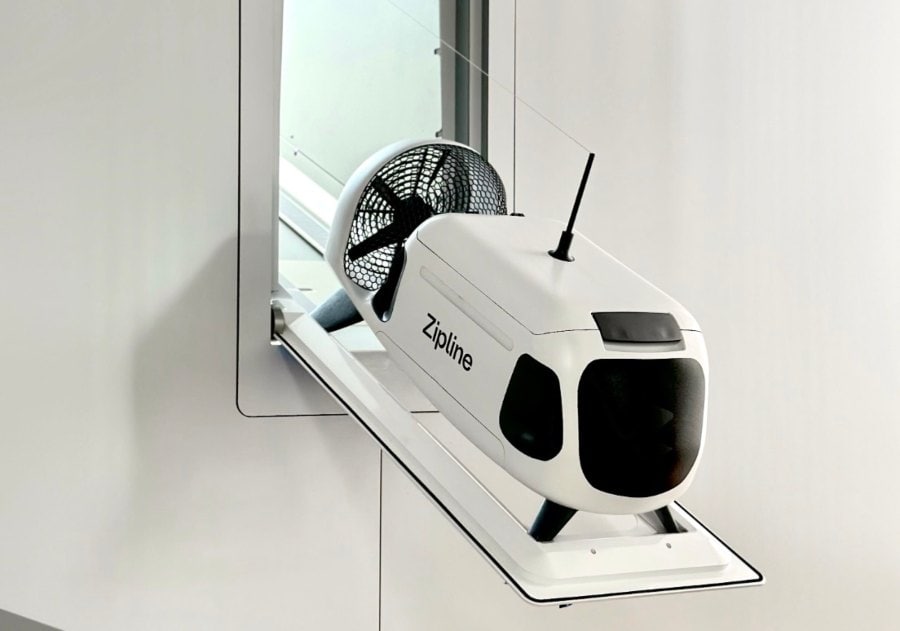Zipline Unveils New Drone-within-a-Drone for Last Mile Delivery
BY Zacc Dukowitz
21 March 2023Drone delivery companies have been stepping up their game recently.
Last week we reported on Wing’s new network, which will use a decentralized model to allow its drones to make several deliveries in a row without returning to the warehouse.
This week, we’re reporting on Zipline’s new delivery droid.
The droid is made to sit within the company’s delivery drone, the P2 Zip. When it’s close to the final destination, the drone opens a small cargo bay and releases a tether, dropping the droid down to make the delivery.
Using this approach, deliveries can be made to very small areas such as a patio table or the front steps of a home.
We have built the closest thing to teleportation ever created—a smooth, ultrafast, convenient, and truly magical autonomous logistics system that serves all people equally, wherever they are.
– Keller Rinaudo Clifton, co-founder and CEO of Zipline
Why Deliver Like This?
According to Zipline, using the droid to make deliveries once the drone arrives at its destination has several benefits:
1. It’s Easy to Load
Because the droids are essentially small, mobile containers, they make the job of loading deliveries much easier.
Check out the delivery process in this short video:


Watch this video on YouTube
2. It’s Easy for Businesses to Implement
The ease of packing the droid solves one of the last remaining challenges for implementing drone delivery using Zipline’s technology.
Here’s what Zipline now has set up for any consumer business that wants to get up and running with drone delivery:
- Docking stations that can be installed on-site to hold and charge delivery drones.
- Third-party friendly software, allowing businesses to leverage other solutions for managing inventory and orders.
- An app for tracking deliveries.
- Autonomy for making the delivery flights—and the droid for actually doing the drop-off, of course.
It’s worth emphasizing that the docking stations provide the infrastructure needed to support the same kind of decentralized delivery network that Wing recently proposed. The stations are relatively small and lightweight, and can be attached to a building or set up as a freestanding structure, making it fairly simple for a local business to start offering drone delivery.


Credit: Zipline
And with the detachable droid, employees at a business can load deliveries without having to deal with the drone directly or leave the inside of the store where they work, streamlining that step of the process.
3. It’s Flexible
Zipline’s docking stations have the potential to provide the same decentralized structure for making deliveries that Wing has laid out in its new network.
If enough businesses have docking stations in an area, the delivery drone can land at the next docking station, swap its empty droid for a full one, and go on to make another delivery. This process could go on indefinitely, since the drone can also get charged up wherever it lands, and isn’t necessarily attached to a single location to charge or load packages.


Credit: Zipline
But the model is also flexible. If it makes more sense for the drone to simply do an out-and-back delivery from a single dock, that works too.
And it’s flexible in how businesses can use it, too. Stores, kitchens, and pharmacies can choose whether to integrate the service into their own apps and websites, join Zipline’s marketplace, or put their own branding on it and call it theirs.
4. It’s Quiet
Zipline has clearly been thinking about the nuisance aspect of drone delivery for a while.
Its drones fly more than 300 feet above the ground, and are nearly inaudible, according to the company.
Further, the new delivery droid was designed to be incredibly quiet. In a poetic turn of phrase, Zipline says the droids are practically silent and “designed to sound like wind rustling leaves.”
Food Delivery Will Be One of the First Offerings
Although Zipline is known as a medical delivery company, it has been branching out into consumer delivery lately.
These new types of deliveries are enabled by the company’s Part 135 certificate, a special certification allowing companies to operate as small aircraft and make drone deliveries BVLOS and over people.


Credit: Zipline
To implement the use of Zipline’s droid and docking station technology, Zipline has partnered with Sweetgreen, a company that makes healthy food.
A central focus of Sweetgreen is on achieving carbon neutrality by 2027. Partnering with Zipline allows it to take a step toward this goal, since drone delivery will reduce the amount of energy required to deliver its meals by a reported 97% (as compared to delivery by a gas-fueled ground vehicle).
The future of delivery is faster, more sustainable and creates broader access, all of which provides improved value for our customers . . . Zipline’s sustainable technology [will] reach customers quickly, with a great delivery experience, [and] help us give our customers what they want, when they want it.
– Jonathan Neman, Co-Founder and CEO of Sweetgreen
Multicare Health Systems and the Government of Rwanda will be using the new droid delivery system for medical deliveries, including prescriptions, medical devices, diagnostics.
Pharmacies Michigan Medicine and Intermountain Health will also be using Zipline’s new droids to deliver pharmaceuticals to people’s homes. According to a recent statement, drone delivery will allow Michigan Medicine to more than double the number of prescriptions it fills each year.
Zipline completed more deliveries in 2022 than in all previous years combined, and is planning to complete about 1 million deliveries by the end of 2023. By 2025, the company expects to operate more flights annually than most airlines.


